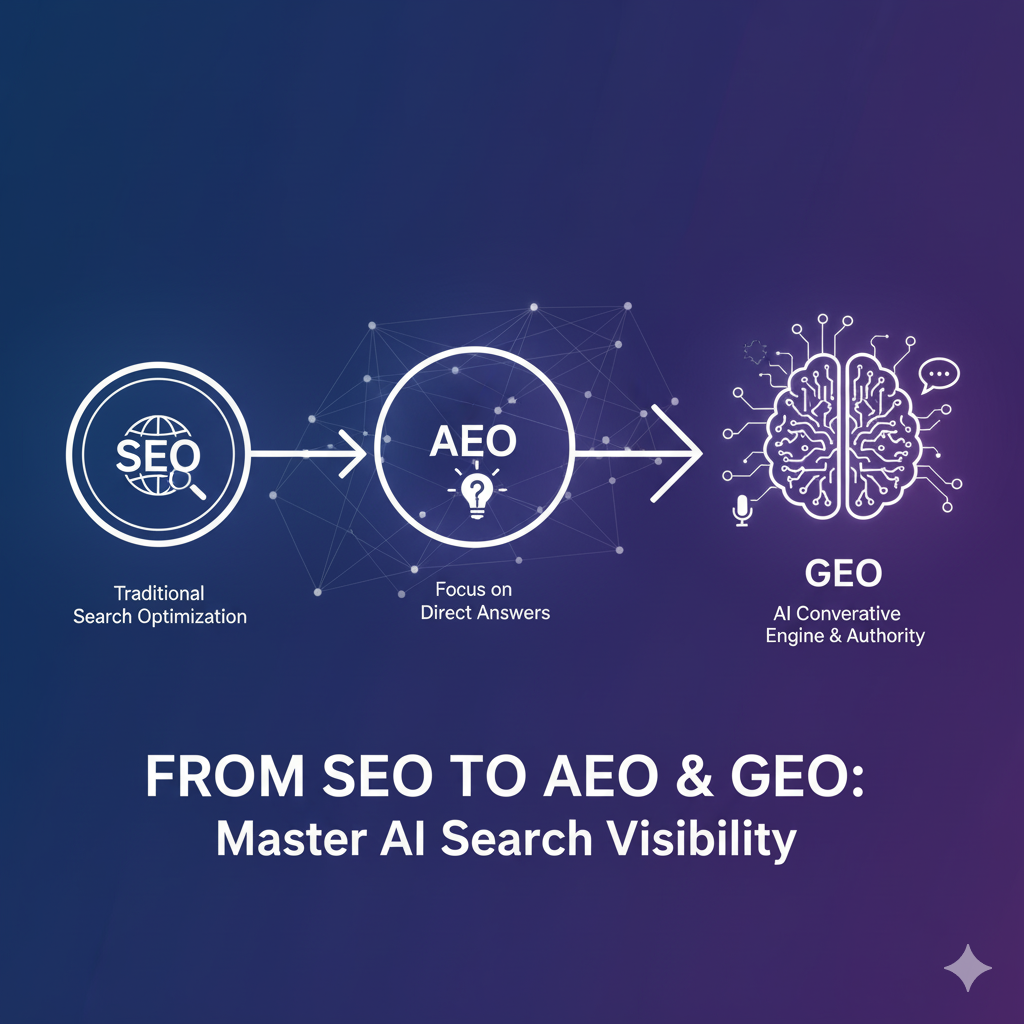You’ve spent years mastering Search Engine Optimization (SEO) , understanding keywords, backlinks , and on-page tactics . But the search landscape is shifting dramatically. Generative AI, AI overviews (AEO) , and conversational search are changing how users find information. This means your strategy needs to evolve too. It’s time to talk about moving from SEO to AEO and GEO visibility, ensuring your brand remains prominent in this new era of AI-powered search.
What is Generative Engine Optimization (GEO) and AI Engine Optimization (AEO)?
Think of Generative Engine Optimization (GEO) and AI Engine Optimization (AEO) as the next evolution of SEO . Instead of solely focusing on ranking for specific keywords, GEO and AEO are about ensuring your content is recognized, understood, and ultimately recommended by AI models and generative search engines like ChatGPT, Perplexity, and Google’s AI Overviews (GAIO).
Traditional SEO heavily relied on matching keywords in your content to user search queries. However, AI search operates differently. It aims to provide direct, conversational answers. This means AI models are looking for content that directly addresses user questions in a clear, structured, and authoritative manner. GEO and AEO strategies focus on optimizing for these conversational queries and the way AI synthesizes information to provide comprehensive answers.
Key differences to consider:
- SEO: Focuses on ranking for keywords in traditional search results.
- AEO/GEO: Focuses on being the source material for AI-generated answers and conversational search.
How AI is Changing B2B SEO and Brand Visibility
The rise of AI search presents both challenges and opportunities for B2B SEO . For years, B2B companies have honed their SEO strategies to capture leads searching for specific solutions, products, or services. Now, AI is changing how those searches are conducted and answered. Instead of navigating through multiple search results pages, users might get a direct answer from an AI, potentially bypassing your website.
This shift directly impacts brand visibility . If your content isn’t optimized for AI consumption, you risk becoming invisible to a growing segment of searchers. Generative AI models are trained on vast datasets, and they prioritize content that is clear, well-structured, and directly answers the intent behind a user’s query. For B2B, this means understanding the complex questions your potential clients are asking and providing definitive, easy-to-digest answers.
The goal is no longer just to appear in search results; it’s to become the trusted source that AI assistants cite. This requires a more nuanced approach to content creation and optimization , moving beyond keyword stuffing towards genuine value and clarity.
Step-by-Step: Transitioning Your Strategy
Successfully moving from traditional SEO to AEO and GEO visibility requires a strategic overhaul. It’s about adapting your content and your thinking to align with how AI engines process information.
Step 1: Identify Where SEO is No Longer Enough
Begin by analyzing your current website performance . Which pages rely heavily on keyword rankings and are showing signs of traffic loss as AI summaries become more prevalent? Understanding these specific pages will highlight where your SEO signals are weakening and where AI visibility signals need to take precedence. This diagnostic step is crucial for prioritizing your optimization efforts.
Step 2: Map Your Content to Real User Questions
AI and LLM visibility thrive on conversational queries. Shift your focus from keyword lists to natural, question-based language. Think about the actual questions your audience asks, such as “how to,” “best way to,” or “which tool should I use.” Aligning your content with these conversational patterns makes it more compatible with how AI systems understand and process information.
Step 3: Restructure Pages for AI Consumption
AI assistants can more easily extract structured information than lengthy paragraphs. Rewrite your content to include clear definitions, step-by-step guides, concise lists, and easily digestible frameworks. The aim is to make every page answer a specific question in an instructional, clear format that AI can readily process and present.
Step 4: Add Visibility-Focused Sections
Enhance your pages with specific sections that help AI models grasp context. Consider adding “Problem and Solution” frameworks, comparative tables, “Follow-up Questions” sections, and concise summaries. These elements provide clear signals to AI, increasing the likelihood of your content being surfaced when users ask related queries.
Step 5: Create Supporting Content for Query Depth
AEO and LLM visibility are often built on topic clusters , not just isolated pages. Develop a network of supporting content that addresses follow-up questions, explores alternatives, offers comparisons, and delves into buying considerations. This comprehensive approach broadens your chances of being referenced across a wider array of conversational search patterns.
Step 6: Track Visibility Across AI Engines
You need to measure your success in this new landscape. Monitor how often your content appears in AI interfaces like ChatGPT, Perplexity, and Google’s AI Overviews. Identify which queries you’re missing and focus on optimizing pages that AI engines are consistently overlooking. Tracking your visibility score is key to refining your AEO/GEO strategy .
Step 7: Shift from Ranking to Recommendation Thinking
This is the fundamental mindset shift. Traditional SEO aims to rank pages. AEO and LLM visibility aim to make your content the definitive answer . Prioritize clarity, structure, and precise intent alignment. AI assistants are more likely to cite sources that offer clear, actionable, and well-organized information, helping users make informed decisions.
Frequently Asked Questions about AI Search Visibility
Securing Your Brand’s Future in AI Search
The transition to AI-driven search is not a fad; it’s the future. By embracing AEO and GEO principles, you can ensure your B2B brand not only survives but thrives. This involves a fundamental shift in how you create, structure, and think about your content. Focus on clarity, direct answers, and conversational intent. By optimizing for AI’s understanding, you position your brand as the go-to resource, securing your visibility and influence in the evolving digital landscape.
Ready to ensure your content is the definitive answer AI provides? Let’s discuss how to implement these AEO and GEO strategies for your business.
